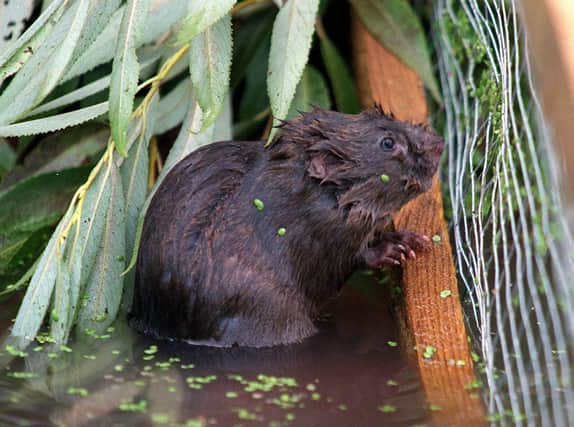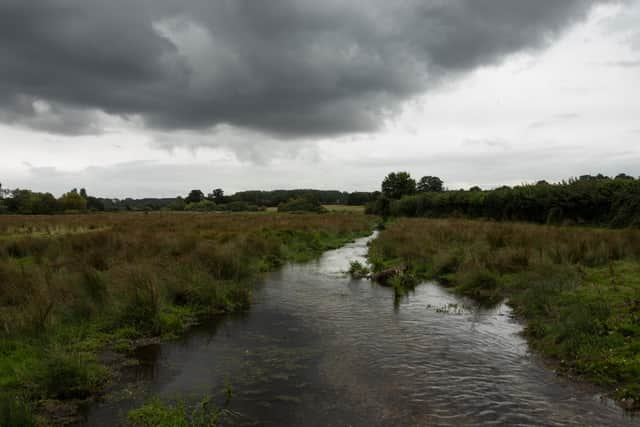England's babbling chalk streams, a habitat compared to the rainforest, are witnessing a staggering decline in water voles – Philip Lymbery


Take the chalk-streams of England, for example. These fragile river systems meander quietly through undulating countryside before disappearing into the sea.
Beloved by fishermen down the ages, chalk-streams are fascinating river systems where everything grows in abundance. Fed by babbling springs, they have their own ecosystem, so unique and biologically productive that experts have come to call them the nation’s rainforests.
Advertisement
Hide AdAdvertisement
Hide AdThere are only about 200 genuine chalk-streams in the world, with 160 of them in England and a few in France.
There is something quintessentially ‘summer’ about the clear, chattering waters of chalk-streams. The gentle verdant banks that wind away through tranquil fields evoke memories of village greens, cricket pitches, long, balmy days with the chink of china crockery and cream teas.
The community of life that thrives in these jewels of the countryside has been the subject of much prose, not least in Simon Cooper’s charming Life of a Chalkstream.
I have always been mesmerised by these magical waters. Walks beside them with our rescue dog, Duke, are punctuated with him running and splashing in the shallows, biting the water and cooling off in it. As he plays, I’m always on the lookout for surprise: wild trout sheltering under a bridge, a heron staring motionless at the passing water; the vibrant flash of a kingfisher.


Liquid aplomb
Chalk streams have long been home to Britain's fastest-declining wild mammal: the water vole. Endearing furry brown creatures that jump into the water with a ‘plop’ before disappearing, the extent of their decline has been staggering.
In the Iron Age, there are thought to have been some 6.7 billion. Over the last 40 years in Britain their numbers have plummeted by 90 per cent, a state of decline comparable to the black rhino of East Africa.
During my childhood in the 1970s, they thrived along the canals and rivers in my native Bedfordshire. I’d hear them more often than I’d spot them – dropping into the water with liquid aplomb, then only a string of bubbles to betray their presence. If I sat quietly enough, I’d catch an occasional glimpse of their comings and goings from a burrow tucked away in the riverbank, just by the waterline.
They were unremarkable back then. Today, the water vole is one of Britain’s most endangered creatures. Though I have whiled away countless days by riverbanks and marshy reedbeds – areas that should be teeming with water voles – I haven’t seen one for more than two decades.
Advertisement
Hide AdAdvertisement
Hide AdConfined to the riparian fringe where farmland meets water, agricultural intensification has meant the wider countryside is inhospitable to these once ubiquitous mammals.
The decline of their chalk-stream habitats and the destruction of bankside sanctums has hastened their demise. Removal of bankside cover has stripped much of their habitat, squeezing them out of existence. As riversides too have become unwelcoming, so water voles have disappeared.
A classic illustration of the problem is in Kent on sections of the Medway, where intensive farming with arable crops comes right up to the river. The edge is flailed and cleared, and the moment the river rises, the banks break away, clogging the river with silt. As the bank collapses, so too does the water vole’s home. That same intensive farming is responsible for chemical runoff, adding pollution to the list of troubles facing our riverine ‘rainforests’.
Yet the final nail in the water vole’s coffin has come from an overseas interloper in the form of the American mink.
Fur farming legacy
The mink now patrolling Britain’s waterways were originally brought from America to be farmed for fur in the 1920s. They were first confirmed to be breeding in the wild in 1956. By December 1967, feral mink were present in over half the counties of England and Wales, and in much of lowland Scotland, taking advantage of the ecological vacuum left by the demise of the otter.
The Game and Wildlife Conservation Trust describes it as a “widespread modern misconception” that in Britain, American mink in the wild originated from mass releases from fur farms by animal-rights activists. Escapes and perhaps deliberate releases by fur farmers occurred decades before the industry became the subject of public protest. Thankfully, farming mink for fur is now banned in Britain. But the legacy of that industry lives on.
Mink are successful and opportunistic predators with a voracious appetite, particularly for water voles.
Today, mink have been recorded in every mainland county of Scotland and England, including colonising some of the many offshore islands of Scotland – a very real threat to internationally important seabird colonies.
All in all, the future has looked bleak for the water vole.
Hope
Advertisement
Hide AdAdvertisement
Hide AdThankfully, there is growing interest in restoring chalk-streams to their former glory and water voles with them.
Efforts are under way to support remaining water vole populations with the help of nature-friendly farmers. Reintroductions have been taking place on rivers across the country, with hundreds being released at one of my favourite haunts, Titchfield Haven in Hampshire.
Water Day on March 22 will promote sustainable management of freshwater resources – and what better indicator of the health of our rivers than the state of chalk streams.
I, for one, will be hoping that we are successful in restoring chalk-streams and our wonderful river systems, and bringing back much-loved wildlife that should be part and parcel of these special places.
In many ways, the future of our natural environment and addressing the growing biodiversity crisis depends upon it, as does the future for our native water voles too.
Philip Lymbery is chief executive of Compassion in Farming International, a United Nations Food Systems Champion and author of Farmageddon: The True Cost of Cheap Meat and Dead Zone: Where the Wild Things Were. He is on Twitter @philip_ciwf
A message from the Editor:
Thank you for reading this article. We're more reliant on your support than ever as the shift in consumer habits brought about by coronavirus impacts our advertisers.
If you haven't already, please consider supporting our trusted, fact-checked journalism by taking out a digital subscription.
Comments
Want to join the conversation? Please or to comment on this article.

